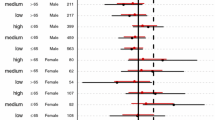Abstract
With rapid advances in understanding of human diseases, the paradigm of medicine shifts from “one-fits-all” to targeted therapies. In targeted therapy development, the patient population is thought of as a mixture of two or more subgroups that may derive differential treatment efficacy. To identify the right patient population for the therapy to target, inference on treatment efficacy in subgroups as well as in the overall mixture population are all of interest. Depending on the type of clinical endpoints, inference on a mixture population can be non-trivial and it depends on the efficacy measure as well as the estimation procedure. In this chapter, we start with introducing the fundamental statistical considerations in this inference procedure, followed by proposing suitable efficacy measures for different clinical outcomes and establishing a general logical estimation principle. Finally, as a step forward in patient targeting, we present a simultaneous inference procedure based on confidence intervals to demonstrate how treatment efficacy in subgroups and mixture of subgroups can be logically inferred. Examples from oncology studies are used to illustrate the application of the proposed inference procedure.
Access this chapter
Tax calculation will be finalised at checkout
Purchases are for personal use only
Similar content being viewed by others
References
Alosh M, Huque MF, Bretz F, D’Agostino Sr RB (2017) Tutorial on statistical considerations on subgroup analysis in confirmatory clinical trials. Stat Med 36(8):1334–1360
Benichou J, Gail MH (1989) A delta method for implicitly defined random variables. Amer Statist Assoc 43:41–44
Berger JO, Wang X, Shen L (2014) A bayesian approach to subgroup identification. J Biopharm Stat 24(1):110–129
Borghaei H, Paz-Ares L, Horn L, Spigel DR, Steins M, Ready NE, Chow LQ, Vokes EE, Felip E, Holgado E, Barlesi F, Kohlhäufl M, Arrieta O, Burgio MA, Fayette J, Lena H, Poddubskaya E, Gerber DE, Gettinger SN, Rudin CM, Rizvi N, Crinò L, Blumenschein GRJ, Antonia SJ, Dorange C, Harbison CT, Graf Finckenstein F, Brahmer JR (2015) Nivolumab versus docetaxel in advanced nonsquamous non–small-cell lung cancer. N Engl J Med 373:1627–1639
Committee for Medicinal Products for Human Use and others (2010) Guideline on the investigation of bioequivalence. European Medicines Agency website, London
Ding Y, Lin HM, Hsu JC (2016) Subgroup mixable inference on treatment efficacy in mixture populations, with an application to time-to-event outcomes. Stat Med 35(10):1580–1594
Ding Y, Li YG, Liu Y, Ruberg SJ, Hsu JC et al (2018) Confident inference for SNP effects on treatment efficacy. Ann Appl Stat12(3):1727–1748
Dmitrienko A, Muysers C, Fritsch A, Lipkovich I (2016) General guidance on exploratory and confirmatory subgroup analysis in late-stage clinical trials. J Biopharm Stat 26(1):71–98
Foster JC, Taylor JM, Ruberg SJ (2011) Subgroup identification from randomized clinical trial data. Stat Med 30(24):2867–2880
Huang Y, Fong Y (2014) Identifying optimal biomarker combinations for treatment selection via a robust kernel method. Biometrics70(4):891–901
Huang Y, Xu H, Calian V, Hsu JC (2006) To permute or not to permute. Bioinformatics 22(18):2244–2248
Kaizar EE, Li Y, Hsu JC (2011) Permutation multiple tests of binary features do not uniformly control error rates. J Am Stat Assoc 106(495):1067–1074
Laber E, Zhao Y (2015) Tree-based methods for individualized treatment regimes. Biometrika 102(3):501–514
Lin HM, Xu H, Ding Y, Hsu JC (2019) Correct and logical inference on efficacy in subgroups and their mixture for binary outcomes. Biom J 61(1):8–26
Lipkovich I, Dmitrienko A (2014) Strategies for identifying predictive biomarkers and subgroups with enhanced treatment effect in clinical trials using sides. J Biopharm Stat 24(1):130–153
Lipkovich I, Dmitrienko A, Denne J, Enas G (2011) Subgroup identification based on differential effect search—a recursive partitioning method for establishing response to treatment in patient subpopulations. Stat Med 30:2601–2621
Lipkovich I, Dmeitrienko A, D’Agostino RB (2017) Tutorial in biostatistics: data-driven subgroup identification and analysis in clinical trials. Stat Med 36:136–196
Loh WY, He X, Man M (2015) A regression tree approach to identifying subgroups with differential treatment effects. Stat Med 34:1818–1833
Qian M, Murphy SA (2011) Performance guarantees for individualized treatment rules. Ann Statist 39(2):1180
Scott LJ (2019) Larotrectinib: first global approval. Drugs 79:1–6
Shen L, Ding Y, Battioui C (2015) A framework of statistical methods for identification of subgroups with differential treatment effects in randomized trials. In: Applied statistics in biomedicine and clinical trials design. Springer, Berlin, pp. 411–425
Spigel DR, Ervin TJ, Ramlau RR, Daniel DB, Goldschmidt Jr JH, Blumenschein Jr GR, Krzakowski MJ, Robinet G, Godbert B, Barlesi F, Govindan R, Patel T, Orlov SV, Wertheim MS, Yu W, Zha J, Yauch RL, Patel PH, Phan S, Peterson AC (2013) Randomized phase ii trial of onartuzumab in combination with erlotinib in patients with advanced non-small-cell lung cancer. J Clin Oncol 31(32):4105–4114
Su X, Tsai CL, Wang H, Nickerson DM, Li B (2009) Subgroup analysis via recursive partitioning. J Mach Learn Res 10(Feb):141–158
US Food and Drug Administration (2012) Guidance for industry: Enrichment strategies for clinical trials to support approval of human drugs and biological products. FDA, Silver Spring
Zhang B, Tsiatis AA, Davidian M, Zhang M, Laber E (2012) Estimating optimal treatment regimes from a classification perspective. Stat 1(1):103–114
Zhao Y, Zeng D, Rush AJ, Kosorok MR (2012) Estimating individualized treatment rules using outcome weighted learning. J Am Stat Assoc 107(499):1106–1118
Author information
Authors and Affiliations
Corresponding author
Editor information
Editors and Affiliations
1 Electronic supplementary material
Rights and permissions
Copyright information
© 2020 Springer Nature Switzerland AG
About this chapter
Cite this chapter
Ding, Y., Wei, Y., Wang, X. (2020). Logical Inference on Treatment Efficacy When Subgroups Exist. In: Ting, N., Cappelleri, J., Ho, S., Chen, (G. (eds) Design and Analysis of Subgroups with Biopharmaceutical Applications. Emerging Topics in Statistics and Biostatistics . Springer, Cham. https://doi.org/10.1007/978-3-030-40105-4_10
Download citation
DOI: https://doi.org/10.1007/978-3-030-40105-4_10
Published:
Publisher Name: Springer, Cham
Print ISBN: 978-3-030-40104-7
Online ISBN: 978-3-030-40105-4
eBook Packages: Mathematics and StatisticsMathematics and Statistics (R0)




